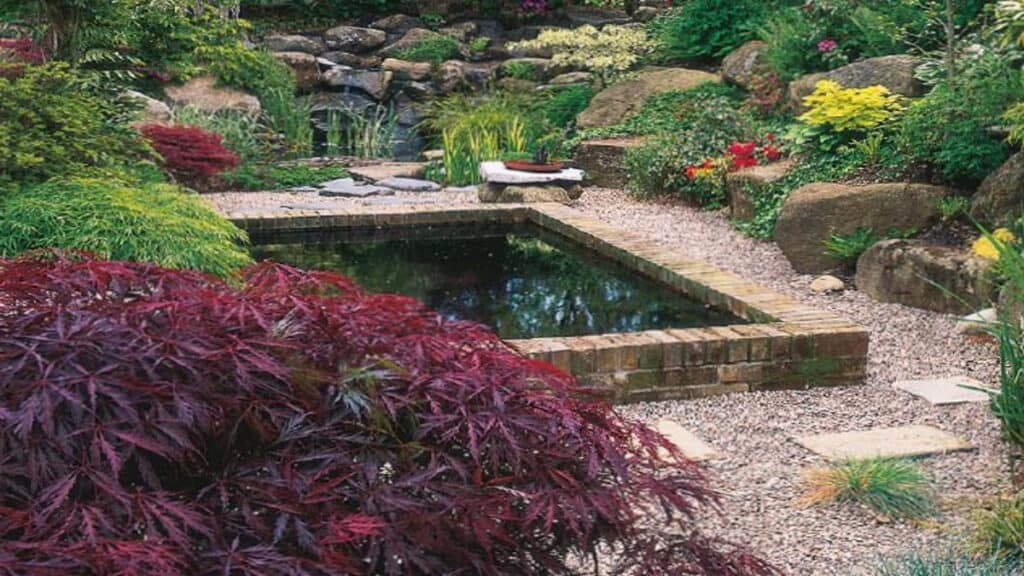Exploring the Tranquil Beauty of Koi Ponds: A Comprehensive Guide ????????????
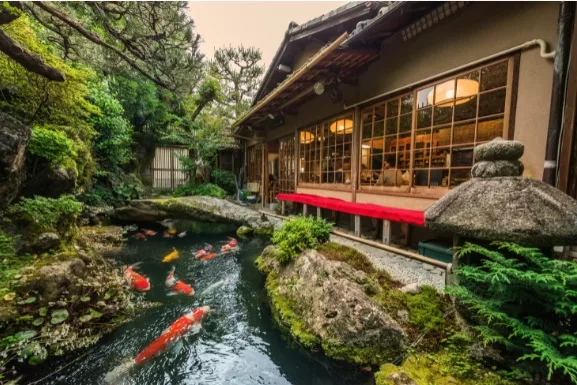
I. Introduction to Koi Pond
A. Definition of a Koi Pond A koi pond is a meticulously crafted aquatic environment designed to house and showcase the captivating elegance of koi fish. These ponds are not just water features but serene sanctuaries that blend artistry with nature. ????️
B. Brief History of Koi Fish Originating from Japan in the 19th century, koi fish were selectively bred from common carp for their vibrant colors and patterns. Initially, they served practical purposes for Japanese rice farmers, but over time, they became revered as symbols of prosperity and good fortune. ????????????
C. Importance and Cultural Significance Koi ponds hold deep cultural significance, particularly in Japanese and Chinese cultures, where they symbolize longevity, perseverance, and success. Today, they are cherished worldwide for their aesthetic appeal and their ability to evoke a sense of tranquility and balance. ????✨
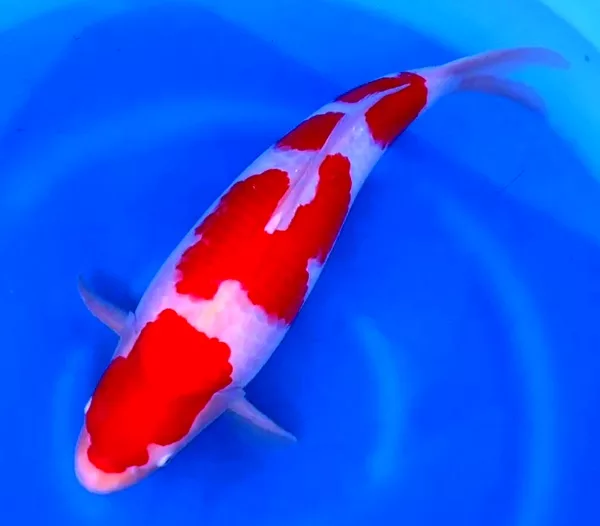
II. Understanding Koi Fish
A. Characteristics of Koi Fish Koi fish are renowned for their striking colors, graceful movements, and sociable nature. With proper care, these majestic creatures can live for decades and grow to impressive sizes, captivating admirers with their beauty and charm. ????????
B. Origins and Native Habitat Originally native to freshwater habitats in East Asia, koi fish thrive in well-maintained ponds with clean water, ample space, and suitable environmental conditions that mimic their natural habitat. ????????
C. Different Varieties and Colors Koi fish exhibit a dazzling array of colors and patterns, ranging from vibrant reds and whites to bold blues and blacks. Popular varieties include Kohaku, Sanke, Showa, and Taisho Sanke, each prized for its unique markings and aesthetic appeal. ????????️
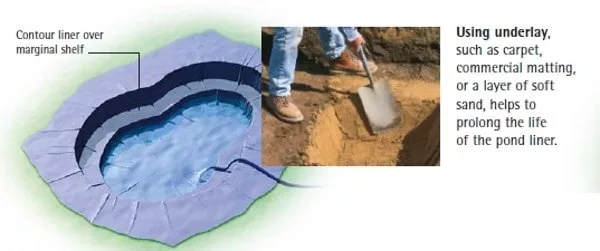
III. Designing a Koi Pond
A. Aquascape Principles Designing a koi pond involves integrating principles of aquascaping to create a harmonious balance between water, landscaping, and hardscaping elements. Naturalistic features such as rocks, plants, and waterfalls enhance both the visual appeal and functionality of the pond. ????????????
B. Planning and Layout Careful planning and layout considerations are essential for creating a successful koi pond. Factors such as location, size, depth, and exposure to sunlight should be taken into account to ensure optimal conditions for the fish and aquatic plants. ????????️☀️
C. Features and Components Key components of a well-designed koi pond include waterfalls, fountains, filtration systems, pumps, and landscaping elements such as rocks, gravel, and aquatic plants. These features not only enhance the visual appeal but also contribute to water circulation, aeration, and biological filtration. ⛲????????
IV. Building and Maintaining a Koi Pond
A. Construction Process Building a koi pond involves several stages, including excavation, installation of liners, sealing, and integration of filtration and circulation equipment. Attention to detail and quality craftsmanship are crucial for ensuring the structural integrity and longevity of the pond. ????????????️
B. Water Quality Management Maintaining pristine water quality is essential for the health and well-being of koi fish. Effective water quality management strategies include the use of filtration systems, regular water testing, oxygenation, and proper feeding practices. ????????????
C. Regular Maintenance Practices Routine maintenance tasks such as debris cleaning, monitoring water parameters, and disease prevention are vital for preserving the beauty and vitality of a koi pond. Regular inspections and proactive measures help mitigate potential issues and ensure a thriving aquatic ecosystem. ????????????
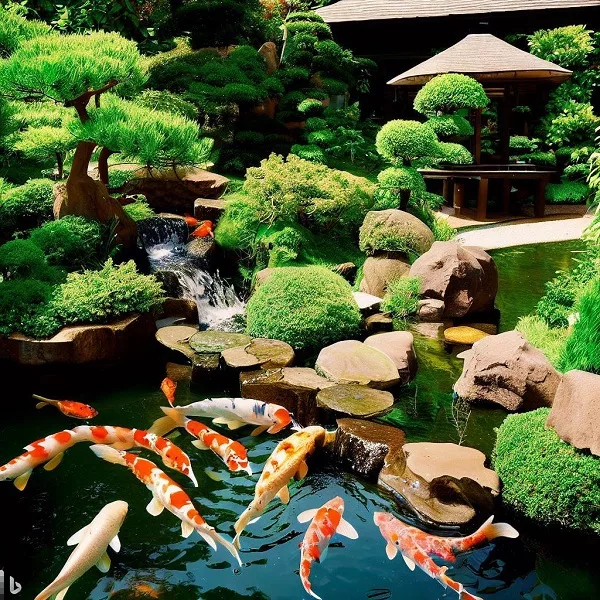
V. Koi Pond Landscaping
A. Garden Pond Integration Integrating a koi pond seamlessly into a garden landscape enhances its aesthetic appeal and creates a tranquil retreat within outdoor spaces. Strategic placement of plants, rocks, and other natural elements fosters a sense of balance and harmony between the pond and its surroundings. ????????????
B. Japanese Influences in Design Drawing inspiration from traditional Japanese garden design principles, koi ponds often feature elements such as Zen rock gardens, bonsai trees, and wooden bridges, reflecting a deep appreciation for nature and simplicity. ????????????️
C. Plant Selection and Arrangement Carefully selecting aquatic plants such as water lilies, lotus, and marginal plants adds beauty and diversity to the pond ecosystem while providing shade, oxygenation, and habitat for fish and other aquatic organisms. ????????????
D. Harmony with Surrounding Environment Creating a harmonious relationship between the koi pond and its surrounding environment involves thoughtful consideration of factors such as scale, proportion, and visual continuity. By seamlessly blending natural and man-made elements, a well-designed koi pond becomes a captivating focal point within the landscape. ????????????
VI. Enjoying and Interacting with Koi Ponds
A. Observing Koi Behavior Observing the fascinating behavior of koi fish, from their playful antics to their graceful swimming patterns, offers endless entertainment and relaxation for pond enthusiasts of all ages. ????????????
B. Feeding Rituals and Techniques Feeding koi fish is not only a practical necessity but also a rewarding experience that fosters a bond between caretaker and fish. By offering high-quality koi food and practicing proper feeding techniques, enthusiasts can promote healthy growth and vibrant colors in their fish. ????️????????
C. Relaxation and Meditation Immersing oneself in the tranquil ambiance of a koi pond provides a therapeutic escape from the stresses of modern life. Whether through meditation, yoga, or simply quiet contemplation, koi ponds offer a sanctuary for relaxation and rejuvenation. ????♂️????????
D. Educational and Therapeutic Benefits Beyond their aesthetic appeal, koi ponds offer valuable educational opportunities for learning about aquatic ecosystems, water conservation, and the importance of environmental stewardship. Additionally, interacting with koi fish has been shown to reduce stress, anxiety, and promote emotional well-being. ????????????
VII. Koi Pond Variations and Adaptations
A. Backyard Koi Ponds Backyard koi ponds are popular among homeowners seeking to enhance their outdoor living spaces with a touch of elegance and tranquility. These ponds come in various sizes and designs, ranging from compact patio ponds to expansive water gardens. ????????????
B. Patio and Small-Scale Ponds Ideal for urban dwellers and those with limited outdoor space, patio ponds offer a compact yet stylish solution for incorporating koi fish into small gardens, balconies, or indoor settings. ????️????????
C. Commercial Koi Ponds Commercial koi ponds are often found in public gardens, parks, and recreational facilities, serving as focal points for relaxation, education, and community engagement. ????️????????
D. Public Gardens and Parks Public gardens and parks frequently feature koi ponds as integral components of their landscape design, providing visitors with opportunities to connect with nature, enjoy serene surroundings, and appreciate the beauty of koi fish. ????????????
VIII. Cultural and Symbolic Aspects of Koi Ponds
A. Japanese Cultural Significance In Japan, koi ponds hold deep cultural significance and are associated with themes of luck, prosperity, and spiritual enlightenment. Traditional Japanese garden design principles, such as wabi-sabi and mujo, emphasize the beauty of impermanence and the ever-changing nature of life. ????????????
B. Symbolism in Different Cultures Beyond Japan, koi fish hold symbolic meanings in various cultures worldwide, representing concepts such as perseverance, transformation, and abundance. Their presence in koi ponds serves as a reminder of the interconnectedness of humans and nature. ????????????
C. Feng Shui and Koi Ponds In Feng Shui philosophy, koi ponds are believed to attract positive energy, or chi, and promote harmony and prosperity within the surrounding environment. Proper placement and design of koi ponds are essential for harnessing their beneficial energies. ????♀️????????
IX. Addressing Common Questions and Misconceptions
A. Are Koi Fish Japanese or Chinese? While koi fish originated in Japan, they are also prevalent in Chinese culture, where they are revered for their auspicious symbolism and decorative beauty. ????????????????????
B. Freshwater or Saltwater? Koi fish are freshwater species that thrive in ponds, lakes, and streams with clean, well-oxygenated water. They are not suited to saltwater environments. ????????????
C. Origins and Native Habitat Koi fish are native to freshwater habitats in East Asia, particularly Japan, where they were first bred and domesticated for ornamental purposes. ????️????????
D. Differences from Goldfish While koi fish and goldfish belong to the same family (Cyprinidae), they are distinct species with different physical characteristics, behaviors, and care requirements. ????????????
X. Koi Pond Calculators and Additional Tools
A. Koi Pond Size Calculator Calculate the ideal size of your koi pond based on factors such as the number of fish, available space, and desired aesthetic appeal. ????????????
Koi Pond Size Calculator
A. Koi Pond Size Calculator Calculate the ideal size of your koi pond based on factors such as the number of fish, available space, and desired aesthetic appeal. ????????????
Koi Pond Size Calculator
B. Koi Pond Salt Calculator Determine the optimal salt concentration for your koi pond to promote fish health and prevent diseases. ????????????
Koi Pond Salt Calculator
C. Koi Pond Cost Calculator Estimate the total cost of building and maintaining a koi pond, including materials, labor, and ongoing expenses. ????????????
Koi Pond Cost Calculator
D. Koi Pond Pump Size Calculator Select the appropriate pump size for your koi pond based on factors such as water volume, flow rate, and head height. ⛲????????
Koi Pond Pump Size Calculator
E. Koi Pond Liner Calculator Calculate the required size and type of pond liner needed to create a watertight seal for your koi pond. ????️????????️
Koi Pond Liner Calculator
F. Koi Pond Gallon Calculator Determine the total volume of water in your koi pond based on its dimensions and depth. ????????????
Koi Pond Gallon Calculator
G. Koi Pond Filter Size Calculator Choose the right size and type of filtration system for your koi pond to maintain water clarity and quality. ????️????????
H. Koi Pond Ozone Generator Explore the benefits of using ozone generators to improve water quality and eliminate harmful pathogens in your koi pond. ????️????????
Koi Pond Ozone Generator
XI. Conclusion
In conclusion, koi ponds offer a captivating blend of natural beauty, cultural significance, and therapeutic benefits that enrich the lives of enthusiasts worldwide. Whether you’re a novice seeking to create your first koi pond or a seasoned aficionado looking to enhance your aquatic oasis, the journey of exploration and discovery awaits. Embrace the tranquility of koi ponds, and immerse yourself in the timeless allure of these enchanting aquatic sanctuaries. ????????✨
IX. Addressing Common Questions and Misconceptions Frequently ask questions faqs
What is a Koi Pond?
A koi pond is a specially designed body of water that serves as a habitat for koi fish. Unlike traditional ponds, which may be primarily decorative or functional, koi ponds are specifically crafted to provide optimal living conditions for koi fish, including filtration systems, aeration, and suitable water depth.
Is a Koi Pond Hard to Maintain?
While koi ponds require regular maintenance to ensure water quality and fish health, they can be manageable with proper planning and care. Factors such as filtration systems, water testing, and routine cleaning play crucial roles in maintaining a healthy and balanced ecosystem within the pond.
Why is it Called Koi?
The term “koi” is derived from the Japanese word for carp, “nishikigoi.” Originally bred from common carp in Japan, koi fish were selectively bred for their vibrant colors and patterns, eventually becoming known simply as “koi” in reference to their ornamental qualities.
What is the Difference Between a Pond and a Koi Pond?
While both ponds and koi ponds are bodies of water, there are significant differences in their design, purpose, and inhabitants. Regular ponds may serve various functions, such as providing habitat for wildlife, supporting aquatic plants, or serving as decorative features. In contrast, koi ponds are specifically tailored to accommodate koi fish, with features such as filtration systems, suitable water depth, and aeration to support the health and well-being of the fish.
You may also like
- https://www.giobelkoicenter.com/koi-fish-meaning/
- https://www.giobelkoicenter.com/most-expensive-koi-fish/
- https://www.giobelkoicenter.com/matsuba-koi/
- https://www.giobelkoicenter.com/koi-egg-bound/
- https://www.giobelkoicenter.com/metronidazole-for-fish/
